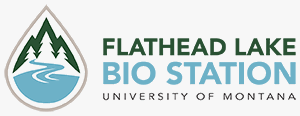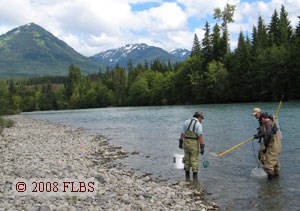SaRON Program Goals
- To quantify biophysical processes producing the Shifting Habitat Mosaic and associated biodiversity in the observatory rivers, in context of influences on salmonid population structure and productivity
- To devise and promote a new conservation and management protocol for wild salmon rivers that is based on the Shifting Habitat Mosaic model
- To understand if riverine habitat quality, defined as intrinsic capacity for productivity, substantially declined due to lack of fertility associated with chronic over harvest of salmon spawners that import marine nutrients into river ecosystems
- To predict how salmon and salmon habitat will respond to ongoing climate warming
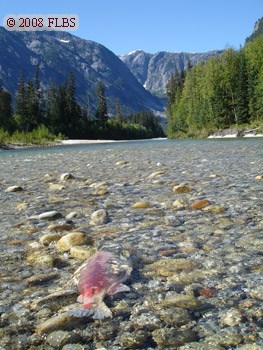 Overview
Overview
The Flathead Lake Biological Station (FLBS) of The University of Montana with the Wild Salmon Center (WSC), Moscow State University (MGU) and other cooperators has assembled a multi-disciplinary team of scientists to document salmonid biodiversity and productivity, as controlled by natural and cultural processes, of a suite of pristine Pacific salmon river ecosystems (observatories). The research focuses on salmonid habitat requirements that appear to vary with life history stage and in relation to population structure. We believe that productivity of habitat is controlled by non-linear biophysical processes that create and maintain a dynamic or constantly Shifting Habitat Mosaic (SHM; described in detail in Stanford et al. 2005) throughout the river corridor from headwaters to the ocean. Our research also addresses how salmon rivers and their stocks will respond to climate change. Runoff and temperature patterns are primary determinants of physical habitat in rivers and therefore critically influence salmon productivity. Since both variables may be changed significantly by climate warming, better resolution of climate effects is needed in order to produce robust conservation strategies for salmon and salmon related biodiversity. Human activities tend to reduce or dampen the variable nature of rivers in ways that should be predictable and, therefore, correctable given a robust understanding and modeling of salmon productivity and population dynamics in the context of the SHM concept.Program History
The program is funded by the Gordon and Betty Moore Foundation as a part of its Wild Salmon Ecosystems Initiative. The FLBS began the program in Kamchatka, Russia, in 2001 under a formal partnership with the WSC and MGU for work on the Kol and Utkholok Rivers. The Kamchatka work is conducted under the auspices of WSC and with logistical support of the WSC office in Petropavlosk as the Kamchatka Salmon Biodiversity Program (KSBP).In 2004, we expanded the research to North America, and began partnerships with the Yukon Delta National Wildlife Refuge of the US Fish and Wildlife Service for work on the Kwethluk River in Western Alaska and the Na'na'kila Institute and Kitamaat Village Council of the Haisla First Nation for work on the Kitlope River in British Columbia, Canada. In 2005, we added the Lower Skeena River in British Columbia to the observatory network, conducting cooperative research with the Kitsumkalum Band of the Tsimshian First Nation. In 2006 we began cooperative research with the Taku River Tlingit First Nation on the Taku River in British Columbia and Alaska. In 2008, we initiated cooperative research with the Tahltan/Iskut First Nation on the Stikine River in British Columbia, and we expanded the geographical range of study rivers to include the contiguous US, conducting research with the University of Idaho on Big Creek in the Salmon River watershed of Idaho and with the Cow Creek Band of the Umpqua Tribe on the Umpqua River in Oregon.
At all of our observatories, we are proactively involving Federal, State, Provincial, Tribal, NGO and local entities with management or conservation interests in our sites and work. Since the inception of the project, we have expanded our collaborators and partners to include British Columbia Parks; British Columbia Ministry of Environment; Fisheries and Oceans Canada; the Alcan Corporation; Alaska Department of Fish and Game; USGS Alaska Science Center; the US Forest Service, University of Idaho, and University of Washington Department of Fisheries.
In 2007 the project expanded beyond field work on the observatory rivers to include an extensive modeling component. Modelers are now using data collected at the observatories to predict the flow of nutrients and materials through different floodplain habitats, and subsequently to predict the potential productivity of different habitats in different rivers. The ultimate goal of the modeling component is to predict which Pacific salmon rivers have the greatest potential for salmon production, given their habitat and other physical and biological characteristics. Modelers are also examining the potential effects of climate change on salmon rivers.
In order to create, calibrate and expand the models, SaRON field crews have been collecting data from a variety of non-observatory rivers. We have been using the SaRON research protocol to conduct rapid, expedition-style research on what we are calling Synoptic rivers. Using outputs from the Riverscape Analysis Project (RAP), Synoptic rivers are being chosen with a variety of characteristics in order to supply information about the natural range of variation found within salmonid rivers. In 2007, Synoptic research expeditions were conducted on the Aniak and Mulchatna Rivers of Alaska, and the Kalum and Taku Rivers of British Columbia. In 2008, Synoptic research expeditions were conducted on the Chitina and Mulchatna Rivers of Alaska, and on the Stikine, Taku, and Exchamsiks Rivers of British Columbia.
The Salmonid Rivers Observatory Network is planned for a 10-year period (2002 – 2012) to allow for long-term measures of processes and responses. The initial funding period (2002-2006) focused on identification of observatory rivers, partnering, initial field measures and development of the SHM sampling protocol for cross-site comparisons. The current funding period (2007-2010) focuses on continued data collection at the long-term observatories, collecting data from Synoptic rivers for use in productivity modeling efforts, and linking the SaRON outcomes with other FLBS projects such as the Riverscape Analysis Project (RAP) and the Rio Grande (South America) Brown Trout Project.
Currently, we are in an analysis period. We are conducting a thorough analysis of the data, preparing papers on our results for publication, and developing an outreach initiative for conservation purposes.
Methods
- Remote Sensing, Multi-Spectral imagery technology, and field mapping are used to classify and quantify different aquatic and riparian habitat types.
- Acoustic Doppler Profiling technology is used to measure depth and velocity and to characterize hydro-geomorphic characteristics of the study rivers and to link those characteristics to processes, production, and/or past events.
- Water temperature patterns and other physical attributes, such as wood debris, substratum size and groundwater upwelling, are used to characterize habitat types found within the Shifting Habitat Mosaic and are viewed as primary controllers of salmonid food supplies, growth and reproduction.
- River chemistry and nutrient availability in the different rivers and habitat types are measured and examined in relation to productivity of food webs within habitat types.
- Plants and animals, including aquatic invertebrates, algae, particulate organic material, fish (both salmonid and non-salmonid) and terrestrial vegetation in the suite of habitat types are examined in a food web context for Marine Derived Nutrients with stable isotope analysis and for food quality with lipid analyses.
- Non-lethal tissue sampling (fin clips) of the different life stages of fishes, initially focused on rainbow-steelhead, are used to document population genetic structure.
- Measurements of salmonid lengths and weights and analysis of otoliths, morphometry, and scull and bone structure are used to determine growth rates and life history strategies.
- Salmonid biodiversity, habitat and diet selectivity, density, movement, and growth rates in the suite of different habitat types are quantified by electrofishing and snorkelling surveys coupled with measurements of length and weight and analysis of scales and otoliths and genetic studies.
- Modeling of nutrient and material cycling are being used to predict potential productivity of different habitat types within different rivers and their floodplains.
- Modeling of climate change is used to predict the potential effects on salmonid rivers.
Data Management
Though hardware and software technologies have improved dramatically, the ecological community continues to be very slow to integrate technological change. Factors such as budgetary constraints, resistance to change, the availability of individual data management alternatives (i.e. Microsoft Excel), and network interconnectivity combine to form a barrier to entry for many institutions.In order to address the larger issues of data integrity such as raw data preservation, data entropy, data access and distribution, and inter-project data comparisons, it is incumbent upon project and data managers to implement scalable architectures to manage collection, centralization, processing, archiving, and reporting capabilities before data collection begins.
Flathead Lake Biological Station has addressed these issues in two ways:
We have developed a defined protocol encompassing data collection in the Salmonid Rivers Observatory Network. This protocol allows researchers to work between many sites across multiple ecosystems and countries while capturing consistent data and descriptions (metadata) through standardized collection techniques. For more information on this protocol, please refer to the full project document, available below.
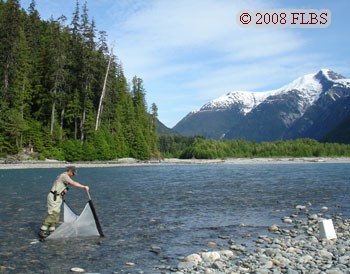 Data Management Demo
Data Management Demo
We have also created the FLBS Ecodata Portal, an interface to a scalable back-end architecture and data management structure capable of ensuring that distributed data is centralized and processed before data or metadata is lost or simply forgotten.Researchers enter, display and update data through an access-controlled collaborative web interface.
Outreach
- List of SaRON Project Publications, Reports, Presentations, and Affiliated Research (through Feb 9, 2009)
Current SaRON White Papers:
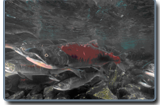
The Salmonid Rivers Observatory Network
Wild Pacific salmon throughout California, Oregon, Washington, Idaho, and southern British Columbia have been declining for more than 100 years...Read the White Paper...
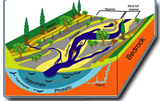
The Shifting Habitat Mosaic
As rivers enter an unconstrained reach from a canyon section, the waters slow...depositing sediment and allowing riparian plants to establish and grow. It is the ecological processes in unconstrained flood plain reaches which are responsible for most of the diversity and productivity of river systems.Read the White Paper...
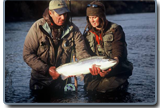
Death of Wild Salmon By A Thousand Cuts
Today, salmon face impacts from a range of human activities. Each activity by itself will not decimate wild Pacific salmon, but the cumulative stresses that wild Pacific salmon face are daunting...Read the White Paper...
SaRON project documents
SaRON project - (Includes Protocol, Goals, Sites, and Science Team)Overview document
Science Team
- Jack Stanford, Program leader - FLBS Director and Professor - Ecosystem processes
- Dr. John Kimball, Co-program leader - FLBS Research Associate Professor -Ecosystem modeling
- Academician (Prof, Dr.) Dmitry S. Pavlov, Co-Program Leader - Head, Ichthyology Department, Moscow State University (MGU) and FLBS Affiliated Professor - Ecology of fishes
- Dr. Richard Hauer - FLBS Professor - Habitat assessment and image acquisition
- Dr. Mark Lorang - FLBS Research Assistant Professor - Geomorphology and physical process measurement/modeling
- Dr. Bonnie K. Ellis - FLBS Research Assistant Professor - Food web ecology; sampling quality assurance and oversight
- Dr. Megan V. McPhee - UAK - Fairbanks - Research Assistant Professor - Salmonid population genetic analyses
- Dr. Ksenia Savvaitova - MGU Professor of Ichthyology and FLBS Affiliated Scientist - Taxonomy and ecology of fishes, especially charrs
- Dr. Kirill Kuzishchin -MGU Associate Professor and FLBS Research Assistant Professor - Taxonomy and ecology of fishes, salmonid life history variation from scale analyses, Science Coordinator for Kamchatka work
- Dr. Marina Gruzdeva - MGU Scientist and FLBS Affiliated Scientist - Salmonid life history and productivity analyses
- Dr. Pavel Kirillov - MGU Scientist and Utkholok Camp Science Lead - Juvenile O. mykiss foraging behavior
- Dr. Jason Mouw - Affiliated (Alaska Department of Fish and Game) Senior Scientist - Riparian ecology
- Dr. Peter Rand - Affiliated (WSC) Assistant Professor - Fish population dynamics (sonar applications) and liaison to State of the Salmon Program (WSC, Ecotrust)
- Dr. Samantha Chilcote - FLBS Senior Post Doctoral Scholar- FLBS Kamchatka Research Coordinator
- Dr. Brian Kennedy - Affiliated Senior Scientist - The University of Idaho, Fish and Wildlife Resources
- Dr. Emily Bernhardt - Affiliated (Duke University) Assistant Professor - Nutrient Modeling
- Dr. Geoff Poole - Affiliated (Montana State University) Assistant Professor - Nutrient Modeling
- Dr. Meredith Wright - FLBS Research Scientist - Nutrient Modeling
- Dr. James Gannon - University of Montana Professor - Nutrient Modeling
- Tom Bansak, M.S. - FLBS Scientist - North American Research Coordinator
- Diane Whited, M.S. - FLBS Scientist - GIS and remote sensing leader
- Phil Matson - FLBS Scientist - GIS and remote sensing processing and synoptic expedition crew leader
- Don Schenck - FLBS Scientist - Data and informatics manager
- Joann Wallenburn, M.S. - Database programming and management
- Jeremy Nigon - FLBS Scientist - Systems and network operations
- Kristin Olson - FLBS Scientist - Analytical chemistry laboratory operations
- Dr. Bob Newell - FLBS Scientist - Aquatic invertebrate taxonomy and SaRON reference collection curator
- Tyler Tappenbeck - FLBS Scientist - Salmon ecology and field crew leader
- Deana Dewire - FLBS Scientist - GIS and remote sensing processing and synoptic crew member
FLBS Graduate Students
Michelle Anderson (Ph.D., juvenile salmonid ecology)
Zach Crete (M.S. parafluvial pond ecology on the Kwethluk River)
Kelly Crispen (current M.S. student - salmonid ecology in the Umpqua River)
Lorri Eberle (M.S. juvenile salmonid feeding ecology on the Kol River)
Aaron Hill (M.S. Kitlope Lake paleo-ecology)
Rachel Malison (current Ph.D. student, juvenile salmonid movement on the Kwethluk River)
Michael Morris (Ph.D., marine derived nutrient cycling on the Kol River)
Sarah O'Neal (M.S. salmonid population ecology of the Rio Grande, Tierra del Fuego)
Tyler Tappenbeck (M.S. riverine sockeye ecology of the Kwethluk River)
Audrey Thompson (M.S. amphipod ecology of the Utkholok River)
CVs available on the FLBS Staff page.
SaRON Field Crews
Kwethluk Field Crew (2009)
- Rachel Malison – FLBS Graduate Student
- John Malison – FLBS Assistant Scientist
- Dan Stone – FLBS Volunteer Research Assistant
- Nathan Hoeme – Yukon Delta National Wildlife Refuge Researcher
- Zach Crete – Yukon Delta National Wildlife Refuge Researcher
- Olin Twitchell – Yukon Delta National Wildlife Refuge Researcher
Umpqua Field Crew (2009)
- Kelly Crispen – FLBS Graduate Student
- Lorri Eberle – FLBS Assistant Scientist
- Jason Coates – FLBS Assistant Scientist
- Josh Epstein – FLBS Assistant Scientist
- Mark Schaffer – FLBS Assistant Scientist
Kitlope Field Crew (2008)
- Tom Bansak – North American Science Coordinator and FLBS Research Scientist
- Tyler Tappenbeck – FLBS Scientist and Field Crew Leader
- Anne Goulet – FLBS Assistant Scientist
- Mark Schaffer – FLBS Assistant Scientist and Field Crew Leader
- Lindsey Magdanz – FLBS Assistant Scientist
- Jim Craft – FLBS Scientist
- Patricia Bolton – Na Na Kila Watchman
- Mike Wilson – Na Na Kila Watchman
Kol Field Crew (2008)
- Dr. Kirill Kuzishchin – Kol Camp Science Leader
- Dr. Marina Gruzdeva – MGU Scientist
- Dr. Pavel Kirillov – MGU Scientist
- Andrei Elnikov – MGU Assistant Scientist
Skeena Field Crew (2008)
- Tom Bansak – North American Science Coordinator and FLBS Research Scientist
- Tyler Tappenbeck – FLBS Scientist and Field Crew Leader
- Anne Goulet – FLBS Assistant Scientist
- Mark Schaffer – FLBS Assistant Scientist and Field Crew Leader
- Lindsey Magdanz – FLBS Assistant Scientist
- Jim Craft – FLBS Scientist
- Russell Bolton – Kitsumkalum Fisheries
- Rob Manion – Kitsumkalum Fisheries
Taku Field Crew (2008)
- Tyler Tappenbeck – FLBS Scientist and Field Crew Leader
- Lindsey Magdanz – FLBS Assistant Scientist
- Mark Connor – Taku River Tlingit Fisheries
- Jerry Jack – Taku River Tlingit Fisheries
Big Creek, Salmon River Field Crew (2008)
- Dr. Brian Kennedy – Affiliated Senior Scientist - University of Idaho Assistant Professor
- Ellen Hamann – University of Idaho Graduate Student
- Kara Cromwell – University of Idaho Graduate Student
Alaska Synoptic Field Crew (2008)
- Dr. Samantha Chilcote – Alaska Synoptic Coordinator and FLBS Senior Post Doctoral Scholar
- Dr. Jack Stanford – SaRON Program Leader and FLBS Director
- Dr. Bonnie Elllis – FLBS Research Assistant Professor
- Diane Whited – FLBS Scientist
- Deana Dewire – FLBS Scientist
- Sarah O'Neal – FLBS Assistant Scientist
- David Colbeck – FLBS Volunteer Research Assistant
- Philip Kedrowski – FLBS Volunteer Research Assistant
British Columbia Synoptic Field Crew (2008)
- Tom Bansak – North American Science Coordinator and FLBS Research Scientist
- Tyler Tappenbeck – FLBS Scientist
- Anne Goulet – FLBS Assistant Scientist
- Mark Schaffer – FLBS Assistant Scientist
- Lindsey Magdanz – FLBS Assistant Scientist
- Russell Bolton – Kitsumkalum Fisheries
- Alex Joseph – Tahltan Fisheries
- Mark Connor – Tahltan Fisheries
Kwethluk Field Crew (2008)
- Nathan Hoeme – Research Coordinator
- Thomas Chandler – Field Crew Leader
- Zach Crete – FLBS Assistant Scientist
- Olin Twitchell – Yukon Delta National Wildlife Refuge
Taku Field Crew (2008)
- Tom Bansak – North American Science Coordinator and FLBS Research Scientist
- Dr. Mark Lorang – FLBS Research Assistant Professor
- Mark Connor – Taku River Tlingit Fisheries
- Jerry Jack – Taku River Tlingit Fisheries
Kol Field Crew (2008)
- Dr. Kirill Kuzishchin – Kol Camp Science Leader
- Dr. Samantha Chilcote – FLBS Russian Science Coordinator
- Marina Gruzdeva – MGU Scientist
- Anna Malutina – MGU Assistant Scientist
- Denis Shavernitsckyy - MGU Assistant Scientist
Utkholok Field Crew (2008)
- Pavel Kirillov – Utkholok Camp Science Lead and MGU Scientist
- Elizabeta Kirillov – MGU Assistant Scientist
- Sergey Sokolov – MGU Assistant Scientist
News
SaRON Research in National Geographic
Where the Salmon RuleSaRON Research on Earth and Sky
Wild Pacific salmon: Death by a thousand cuts (dead link)Saving Wild Salmon: A sustainability-based solution (dead link)
As Salmon Continue to Decline... (dead link)
SaRON Research in NY Times
To Study Russia's Rainbow Trout, Catch Them FirstSalmon Find an Ally in the Far East of Russia
